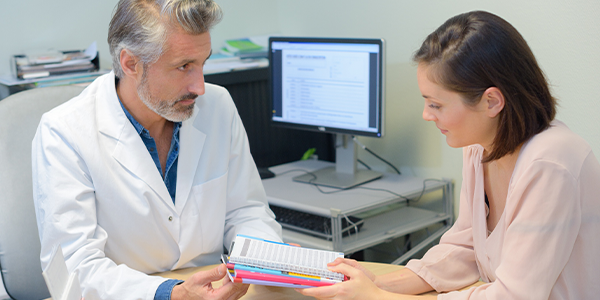After hitting a peak in early April, it had looked like the coronavirus (COVID-19) outbreak would die down thanks to measures such as stay at home orders and social distancing. However, data from the Centers for Disease Control and Prevention (CDC) show that the new infection rate is starting to rise again (as of June 23).
With businesses starting to open back up and people returning to work, infection rates may soon rise again. To ensure both doctor and patient safety, orthopedic clinics need to follow a few coronavirus best practices in the design of both their physical office and their clinical workflows.
Everything from the placement of chairs in the waiting room, to how patients are ushered through the clinic, to how doctors interact with their patients needs to be carefully reviewed in light of infectious disease risks.
Infectious Disease Risks and Medical Practices
The risk of infections is nothing new for any medical practice—not even orthopedic clinics. Healthcare-associated infections (HAIs) are almost inevitable in a medical facility. For example, in 2018, the CDC reported a total of 19,188 Central Line-Associated Bloodstream Infection (CLABSI) incidents across 3,586 acute care hospitals in the U.S.—or roughly 5.35 infections per facility.
It is possible for a patient to come into an orthopedic practice complaining of an inflamed elbow or knee joint thinking it’s because of a sprain or other injury, but it actually be caused by bacterial infections like staphylococcus. Or, a patient with sports-related injury may have contracted an unrelated infection (such as a cold) from another player.
During the outbreak of a major contagious condition like COVID-19, both patient and doctor safety rely on good orthopedic clinic design and the enforcement of rules that limit the spread of infectious diseases. While some infections may occur despite all precautions, following some coronavirus best practices can help keep these numbers low and prevent high-risk patients (and doctors) from being exposed unnecessarily.
Coronavirus Best Practices for Office Design
Redoing your orthopedic clinic design doesn’t necessarily have to mean a complete renovation. There are many simple things that administrators and doctors can do to modify their office’s existing design to reduce the risk of spreading infectious diseases that won’t require major remodeling:
- Space Out Your Waiting Room. If possible, move seating so that there is six feet of space between each seat—this may require temporarily removing seating. If seating is not movable (such as benches or chairs that are bolted to the wall or floor), consider using tape or placing signage on chairs/benches so patients cannot sit directly next to one another.
- Provide Flyers and Install Signs with Coronavirus Best Practices. Printing up flyers and placing signs informing patients of coronavirus best practices can help keep them informed (increasing safety). They can also serve to remind clinic staff of the proper procedures to follow to prevent infections. The CDC has a variety of printable COVID-19 resources that orthopedic clinics could use to increase awareness.
- Install Sanitation Stations. Touch-free hand sanitizer dispensers and other hygienic tools can help visiting patients maintain an extra degree of cleanliness. This, in turn, helps reduce the risk of spreading COVID-19.
- Consider Removing Magazines and Toys from the Waiting Room. Many medical practices keep a variety of “time killers” in their waiting rooms to help patients pass the time. However, magazines, puzzle blocks, and TV remote controls can all be hotbeds for contagion. Removing these items from the waiting room (or at least sanitizing them extremely well) is a must for disease prevention.
- Install Sneeze Guards at the Reception Desk. Some patients may not be wearing face masks when they visit the clinic. To help protect staff from incidental exposure, installing sneeze guards is a must. A clear plastic barrier can allow staff members handling patient intake to interact with patients while protecting them from coronavirus-laden saliva particles.
Additional Patient and Doctor Safety Tips
Aside from modifying the layout of their offices, orthopedic practices may benefit from following a few other tips to improve doctor and patient safety amid worries about the coronavirus:
- Ensure All Staff Have Access to Appropriate PPE. Personal Protective Equipment (PPE) is crucial for preventing infections among clinic staff. At a minimum, those interacting with patients should have a face mask/N95 respirator and gloves—with additional equipment such as face shields and isolation gowns being optional for situations where contact with aerosols or fluids is more likely.
- Enforce a Strict Mask Wearing Policy for Patients. Patients should, for their own protection and the safety of others, wear a mask when in the clinic. Posting a firm policy on wearing masks and enforcing it is a crucial step for protecting patients, doctors, and clinic staff from infectious diseases like COVID-19. If necessary, it may be a good idea to keep a supply of disposable face masks on hand to provide to patients who may not have their own.
- Focus on Telehealth when Possible. The American Medical Association (AMA) urges care providers of all specializations to “Opt for telehealth over in-person visits as much as possible.” Conducting remote patient visits using telehealth solutions not only helps limit infection risks, it can help an orthopedic clinic get in touch with patients they may not have been able to otherwise!
- Encourage Patients to Make Appointments as Much as Possible. Scheduling patient visits ahead of time and spreading visits out to minimize the number of people in the office at once can help prevent crowding. This, in turn, can help to reduce patient and doctor exposure to coronavirus infections. It may be necessary to reschedule some appointments and to postpone routine visits or elective procedures for some patients.
These are just a few COVID-19 best practices that orthopedic clinics can follow to minimize infectious disease risks. For more information about how your practice can better manage patient intake or conduct remote visits, reach out to the Phoenix Ortho team today!
Schedule a 1:1
Get in touch with Phoenix Ortho to learn more about how you can save time, money, and mouse clicks with an orthopedic-specific EHR.






















